4 Types of Fertilizer and How to Choose One
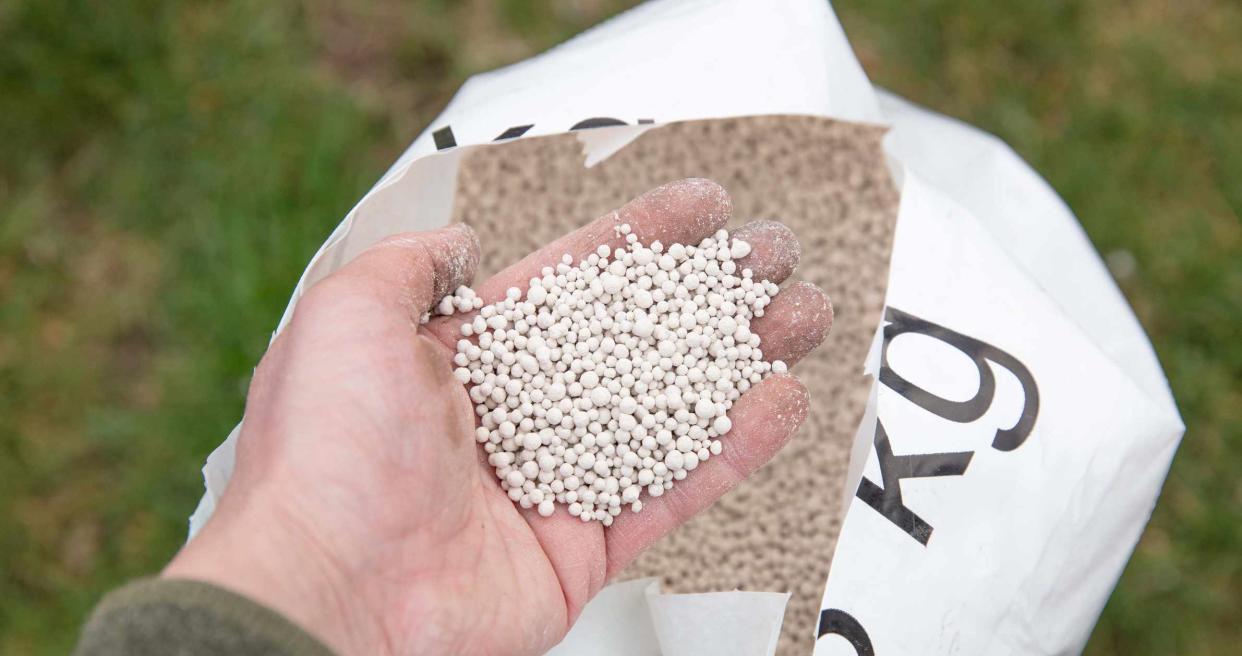
Annick Vanderschelden / Getty Iages
Reviewed by Amanda Rose Newton
Four types of fertilizers—compost, mulch, commercial synthetic products, and organic products—come in several forms and are applied using different methods. All fertilizers provide nutrients to feed the plants in your landscape, but each offers benefits that more accurately and efficiently target specific projects like a vegetable garden or lawn.
What Does NPK Mean?
When you buy fertilizer, you will see an NPK ratio on the packaging, for example, 15-10-10. This ratio means the fertilizer has 15% nitrogen, 10% phosphorus, and 10% potassium. All plants need these three elements to grow. Some types of plants need more of these elements than others, which is why some contain different ratios. This ratio is listed on all synthetic fertilizer packaging and most organic fertilizers.
Here's a review of the four different types of fertilizer, their uses, and guidance on choosing the best one for your green thumb project.
Synthetic Fertilizer
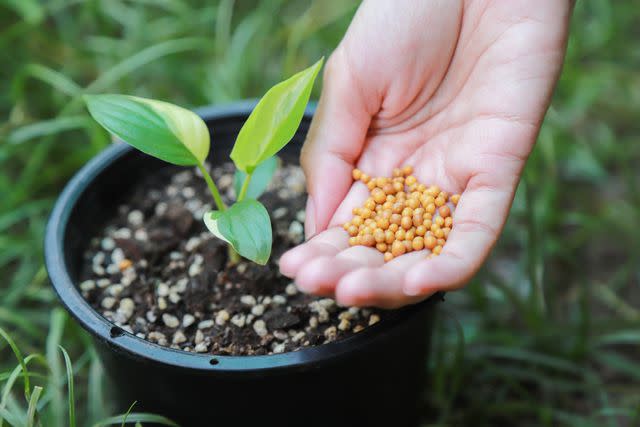
Aphawat Chuangchoem / Getty Images
Best for: Rapid results, lawns
Synthetic fertilizers are manufactured chemicals available as slow-release products, full-strength, ready-to-use, or concentrates that you mix at home. Depending on your needs, they can quickly provide nutrients or slowly release them to your lawn, flower beds, and vegetable gardens.
Synthetic fertilizer comes in all-purpose, balanced formulations or special formulations that target specific plants, such as tomatoes, roses, flower bulbs, trees and shrubs, or houseplants. Some formulas promote blooms, while others strengthen foliage or root growth.
Pros and cons of synthetic fertilizer include:
Easy to apply: Synthetic fertilizers are relatively easy to use and can be added to soil before and after planting.
Works fast: You may see results almost immediately using synthetic fertilizer.
Great for lawns: Synthetics are the most practical option for keeping lawns lush, green, and weed-free. They can be easily applied to existing turf where other fertilizers, like compost or mulch, would smother and kill existing grass.
Needs repeated applications: Requires more frequent reapplication.
More expensive: This type of fertilizer is one of the costliest.
Comes in many forms: Can get it in liquid, powder, granules, and spikes.
Synthetic Fertilizer Forms
Liquid: Often diluted with water or added when soil is wet after watering or rainfall, some liquid fertilizers can also be applied directly onto leaves for nutrient uptake.
Granules or powder: This form works best when watered in or worked into the soil.
Spike fertilizers: Explicitly made for trees and houseplants, these gradually released spikes are pushed into the ground (trees) or pot (houseplants). They break down over time for longer, continuous feeding.
Compost
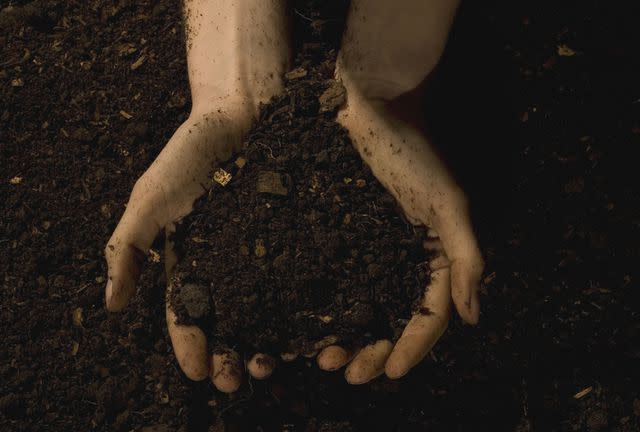
WIN-Initiative / Neleman / Getty Images
Best for: Improving soil, vegetable gardens
Compost is a mix of organic materials like grass clippings, dry leaves and other decaying plant material, kitchen scraps, and manure. It is most often applied by tilling or digging it into existing soil. Compost is an excellent annual addition to vegetable gardens, flower beds, and shrubs but not practical as an addition to existing lawns.
Pros and cons of compost include:
Recycle your food scraps: You can make your own compost pile or purchase them by the scoop or bag. This method is eco-friendly and attracts beneficial organisms and microorganisms.
Inexpensive method: Usually inexpensive but may have setup costs.
You can add it anytime: It is easiest to add before planting, but it can also be added during planting or afterward as a side dressing.
Slow-acting: Compost has to break down in the soil before the nutrients are available to plants, which makes this a slow-acting fertilizer with long-term results.
Adds nitrogen: Compost is a good source of nitrogen.
Improves soil texture: improves the texture of your soil, helping with aeration and water drainage.
Tip
Planting a cover crop is another way to add compost to your vegetable garden. Different types of clovers, buckwheat, and alfalfa are planted in the fall or early spring and then tilled in before planting. Cover crops decay and break down to add nitrogen to the existing soil. They can also crowd out unwanted weedy growth.
Commercial Organic Fertilizer
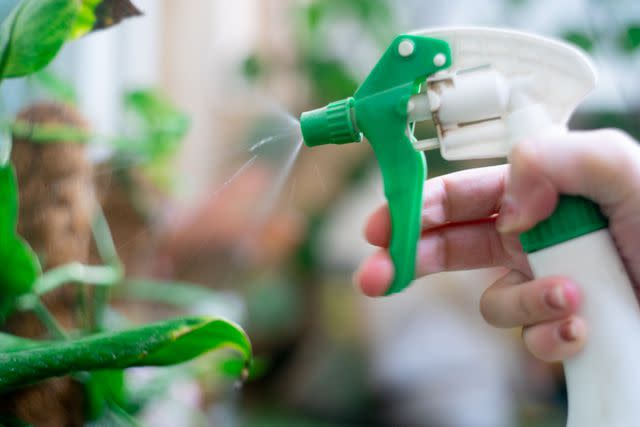
Amlanmather / Getty Images
Best for: Small applications, discouraging rodents
Common commercially packaged organic fertilizers include naturally sourced ingredients, such as bloodmeal, bonemeal, bat guano, fish emulsion, and kelp meal. Some products boost soil acidity or alkalinity, while others add a specific element.
Pros and cons of commercial organic fertilizer include:
Expensive: Cost is a factor when choosing these organics. Applying them to large garden areas can be cost-prohibitive.
Effective: They work very well for small, specific applications like fertilizing certain vegetables and flowers.
Best used for small areas: Plants that need a specific nutrient type or are intended for eating are great candidates for organic fertilizers.
Commercial Organic Fertilizer Types
Bloodmeal: Plants like cole crops (cabbage, broccoli, cauliflower) are heavy feeders that like the nitrogen from bloodmeal, while its odor repels rabbits and other small rodents.
Fish emulsion: An excellent foliar spray for feeding seedlings.
Bonemeal: High in phosphorous, promoting root growth to support healthier plants.
Worm castings: Earthworm excrement is a microbe-rich, slow-release byproduct that stimulates plant growth and can feed for two months.
Animal manure: Usually purchased by the bag, animal manure may contain added compost. Commercially sold livestock manure is prepared under controlled high-heat conditions to kill pathogens and is generally safer than manure fresh from the barnyard.
Mulch
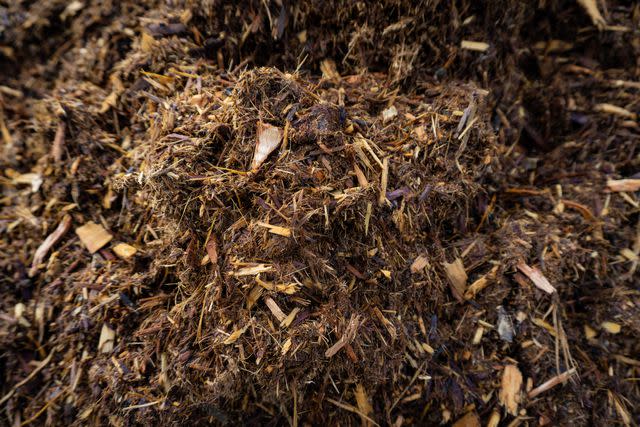
Melinda Podor / Getty Images
Best for: Protection, appearance
Natural mulch looks lovely as a top dressing in landscaping. It consists of tree bark, straw, decaying leaves, and other natural materials. The materials eventually break down and provide nutrients to the soil.
Pros and cons of mulch include:
Eco-friendly: Natural ingredients, no negative impact on the environment.
Retains moisture: One of its primary purposes is to help hold in moisture, preventing evaporation from the topsoil.
Maintains soil temperature: Keep the soil surface at a consistent temperature in summer and winter, protecting roots.
Suppresses weeds: Mulch covers the soil, preventing errant seeds from finding soil, taking root, and avoiding the sun from reaching the soil to activate dormant seeds.
Synthetic mulch, made of rubber, stone, plastic, or newspaper, contains inorganic materials, dyes, or, in the case of stone—minerals—that leach into the earth, take a long time to decompose, and can hurt the earth. Even some decorative tree barks are artificially dyed with deep red pigments that can harm the environment.
Communities often offer free mulch to property owners, usually containing wood chips, clippings, and other natural materials. This mulch is almost always a compilation of waste materials collected from yards or public works projects, so be selective about how and where you use it.
Natural Mulch Types
Wood: Common tree bark mulches are cedar, pine, and hardwood and usually come in three sizes: shavings, chips, or nuggets.
Straw: Straw is sold by the bale in most places, and pine straw, another popular natural mulch, is sold by weight.
Grass and leaf clippings: Grass clippings and leaves are usually gathered from your yard. These types of mulch slowly break down over time to add nutrients and improve the texture of the soil.
Choosing a Fertilizer
Choosing the best fertilizer for your yard and garden projects can be a simple process, and you don't always have to limit yourself to just one type. You can add a nitrogen-rich synthetic fertilizer to start your vegetable garden and then side-dress your crops with compost, manure, or commercial organics mid-season.
Synthetic Fertilizer
When you need a product that can be easily applied to an existing planting, such as a lawn, established flowerbed, or trees and shrubs, synthetic fertilizers work to boost growth and don't require disturbing the soil. A large vegetable garden will benefit from an early application of slow-release granular fertilizer high in nitrogen before you transplant or sow seed. They are also easy to use for flowers and houseplants.
Organic Fertilizer
Commercial organic fertilizer also works well for your orchid collection, houseplants, roses, and any other specific plant or small crop planting type. Environmentally conscious gardeners and farmers will lean heavily on organic ingredients. Consider using organic fertilizer for fruits and vegetables intended for personal consumption.
Compost
In many circles, compost is an organic fertilizer; in other circles, it's a soil amendment. Regardless, one of its purposes is to provide nutrients to the soil and plants. Compost is organic and easiest to add before planting. It works best for long-term soil improvement.
Most vegetable gardens are planted in the same place yearly, depleting nitrogen. The nutrients must be constantly replenished, making an annual addition of organic compost the ideal fertilizer for edible crops. Compost can be worked into soil for new flowerbeds, added when planting, or applied as a side dressing to flowers and food crops during the growing season.
Natural Mulch
Natural mulch serves as a finishing touch to flowerbeds and landscape plants. It is applied in the spring or fall and, when added annually, will slowly break down as a slow-release fertilizer for your garden projects. A few natural mulches, straw or decaying leaves, can work in a vegetable garden but because they break down more slowly than compost, won't supply the annual nitrogen requirement for most crops. Although bark mulches don't work well in the vegetable garden, they are effective when combined with synthetic fertilizers for flowerbeds and trees.
Frequently Asked Questions
What fertilizer makes plants grow faster?
Fertilizers high in nitrogen usually make plants grow faster; nitrogen is a primary component in chlorophyll, driving photosynthesis and giving the plant energy to grow. However, if you're looking for flower, fruit, or vegetable production, get a fertilizer higher in phosphorus and potassium.
What's better, liquid or granular fertilizer?
Liquid fertilizer is your best bet if you need to get nutrients to your plants immediately. Most granular fertilizers are soluble in water, so they can be turned into liquid immediately; however, the beauty of granular fertilizers is that they are timed-release. If you sprinkle granules on your soil with water and time, the plant will gradually absorb the nutrients.
What fertilizer do farmers use?
Most commercial farmers use a nitrogen-heavy mixture on their crops, using chemical compounds such as ammonium sulfate, ammonium nitrate, urea, monoammonium phosphate, and diammonium phosphate.
Read Next: How to Choose the Right Flower Fertilizer Type
Read the original article on The Spruce.

